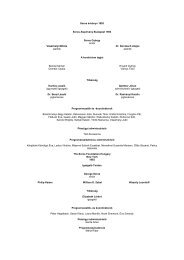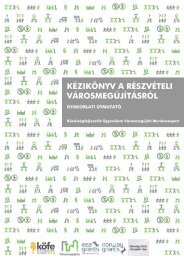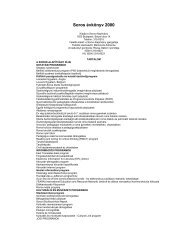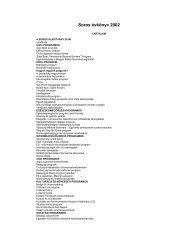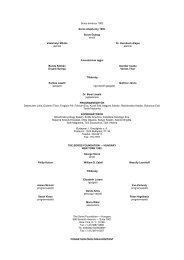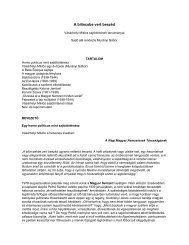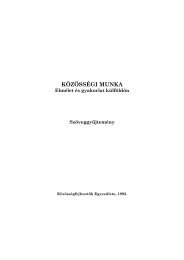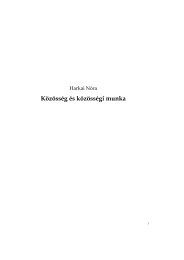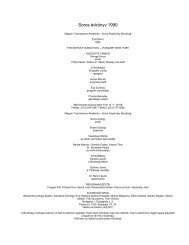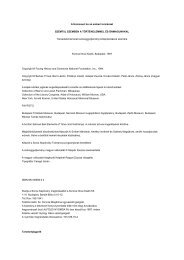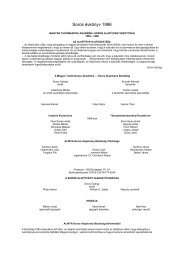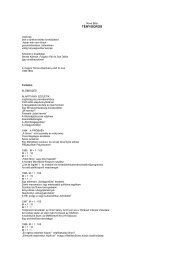You also want an ePaper? Increase the reach of your titles
YUMPU automatically turns print PDFs into web optimized ePapers that Google loves.
SUMMARY<br />
FACT/<strong>SOROS</strong> <strong>II</strong>.<br />
THE SECOND DECADE OF<br />
THE <strong>SOROS</strong> FOUNDATION HUNGARY<br />
1995-2004<br />
Thisbookisanaccount,throughrecollections,studies,picturesanddocuments, of the second decade of the<br />
Soros Foundation Hungary, a private institution which has wielded a uniquely strong influence on<br />
public life, arts, literature, culture, research, education and health in Hungary.<br />
Founded in the Orwellian year of 1984 by Hungarian-born American businessman George Soros with<br />
an endowment of one million dollars, the Foundation was intended to support independent intellectual,<br />
cultural and public initiatives that would serve the development and general democratization of<br />
Hungary, still under Communist rule. It was an experiment that was to form the precedent for another<br />
dozen Soros foundations throughout the region, and was in itself a striking success. Over the ensuing<br />
twenty years, the Hungarian Foundation has spent another 150 million dollars on the most diverse<br />
public causes and private individuals.<br />
Thetwenty-yearlifeoftheorganizationhasbeenattendedbyacceleratingchange and a search for dynamic<br />
balance, within and without. Its history can be broken down into four successive, and highly distinct,<br />
periods:<br />
I. 1984 to 1990<br />
<strong>II</strong>. 1990 to 1994<br />
<strong>II</strong>I. 1994 to 2000<br />
IV. 2000 to 2004<br />
*<br />
Thefirsttwoperiodswerecoveredinthelast“decadereport”(Tény/Soros - 1984- 1994. Balassi Kiadó,<br />
Budapest, 1999), but for the sake of continuity and to follow the changes, it is worth summarizing them<br />
brieflyhere.<br />
I.<br />
FROM THE BEGINNING TO 1990<br />
It was in the late Kádár years, just about the time of the Gorbachov opening, that the “Hungarian<br />
Academy of Sciences Soros Foundation Committee” was set up. From the start, it was something of a<br />
cuckoo’s egg in the rigid, hierarchical, one-party Communist nest. The regime gave its blessing to the<br />
experimental initiative partly as a propaganda gesture to the West and partly from simple pragmatic<br />
considerations (general lack of funds and foreign exchange particularly in the areas of culture,<br />
education and research). The future of the new organization remained precarious in the first two or<br />
three years, because its struggle for publicity and autonomy set off waves of conflict in the system, as<br />
testified by contemporary documents that survive from the Ministry of the Interior, the party<br />
headquarters and academic circles. Nevertheless, with its immediately-popular literature and social<br />
studies grants - which were judged on a strikingly independent basis, sometimes clashing with the<br />
authorities - and a whole range of much-missed and innovative initiatives (like the substantial grants<br />
for libraries, the Xerox program and a raft of foreign grants and study trips) it earned greater and<br />
greater recognition and respect among both the intelligentsia and even reform-minded sections of the<br />
state apparatus. A breakthrough came on the threshold of the change of system: in 1988-89, when its<br />
popularity was at a peak, it attained the position of one of the main catalysts of the democratic<br />
transition, with generous donations backing up the “broad opposition people’s front policy”. The honors<br />
for this initial four or five years undoubtedly go to the founder’s personal representative Miklós<br />
Vásárhelyi and a handful of close, dedicated colleagues. ThesuccessoftheHungarianFoundation was<br />
undoubtedly a major factor in George Soros’ decision to launch, on what was now a well-tried pattern,<br />
a succession of new foundations in Poland, Russia, China and then further Central-Eastern Europe<br />
countries.



